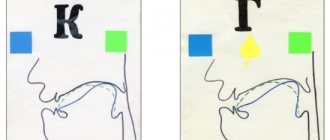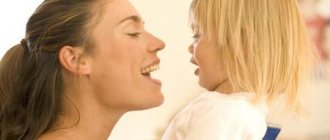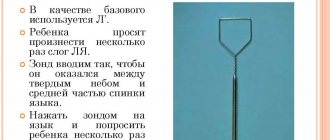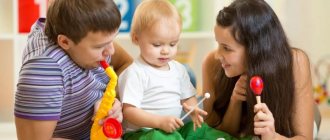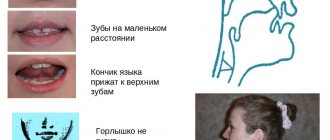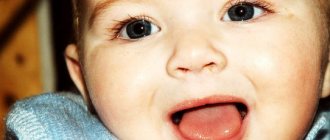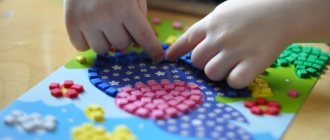This educational game is intended for young children. In the period from 1 to 3 years, it is important to help awaken interest in the world around us and its diversity. With the help of the game “Our Body” he will learn to identify parts of the human body, and then other animals. An educational game for a child develops memory and ability to analyze. It allows you to satisfy your baby's curiosity. He finds similarities and differences in the structure of children and adults. Then he pays attention to this when comparing cats, dogs, toys. Gradually, the child learns what parts of the body are needed for and what functions they perform. There are similar games online. But the vision of a child of this age is sensitive to bright screen light and high color.
Game "Our Body"
To begin with, you only need to play it together. The host can be mom or dad. Start with the preparatory stage.
First stage. She simply touches a part of the child's body and says what it is called. Here tactile, auditory, and visual memory is immediately triggered. The baby feels a touch, hears a word, sees this area of the body.
- Tummy. Where's the belly? Here's the belly! - Hand. Where's the hand? Here's a pen!
If the baby is still a year old, then limit yourself to 2-3 items. It will be difficult for the baby to remember more and he may begin to get confused. The child will learn the name, construction of the question and how to answer.
Second phase. Start showing off body parts not only on your baby, but also on yourself. Introduce the concept of magnitude, difference.
- Cheeks. Your cheeks are here. Here are my cheeks. You have them small because you are small. In adults they are larger because they are bigger.
To help, you can use songs or rhymes for little ones about body parts. Use them while reading and encourage your child to repeat after you.
“Hands clap-clap-clap (clap your hands),
With your feet, stomp-stomp-stomp (we pretend to walk in place, stomp),
Head so-so-so (we shake our heads from side to side),
Belly op-op-op (pat the belly).”
Such catchy rhymes and actions lift your spirits, and rhyme helps you remember names better. When the baby learns all the basic elements of the body, then you can start the game itself.
Rules of the game
We ask the child a question and ask him to show this part of the body on himself, and then on the presenter. The baby already remembers how the questions from the preparatory stage sound.
- Show me where your eyes are. Now show me where mom’s eyes are. - Show your fingers where your hair is, and mom’s? -Where are your legs? What about mine?
Praise your child if he guesses right. For children of this age, this is the best reward. He likes to hear kind words and see your pleasure from his answers. Remember, your positive emotions are transferred to the baby. If he hears approval from you, he won’t get tired of the game. He will happily return to her again. Praise motivates you to try to learn more.
Later you can add two more “players” to the game. Let these be different toys. It is best if you add a doll, a teddy bear, a horse or a dog, or a cat to the company. It is good if some animal stands upright on all fours. This will help the baby to clearly see the differences. Don't think that the doll is only suitable for girls. When studying the body, the human body is best shown. You can find a boy doll, Pinocchio or a soldier.
Now the task changes a little. Place all the toys in a row. Ask your baby to point out body parts. The child begins to understand that despite the fact that they are different, their body structure has something in common. Then invite him to reflect on the differences.
— Show which of the toys has the biggest eyes. Who has the smallest ones? - Who has the longest legs (arms), and who has the shortest?
Also, you can ask to show what one toy has that the others don’t. For example, it could be a tail.
New stage. In addition to three-dimensional objects, you can use drawings. Ask what is where characters have in books, coloring books, and other drawings. The child develops an understanding of the body through pictures. You can draw simple pictures yourself according to the principle: “Hands, legs, cucumber - it turned out to be a little man”, “Dot, dot, comma - it turned out to be a crooked face.” The child will learn not only body parts on the torso, but also on the face.
Clippings. You can print and cut out images of body parts with scissors. The child's task is to put them in the right order. This is done in games for smartphones and other devices. If the picture is outline, then it can be colored.
Picture with a hint. The child can look at the clue and put it in the person.
Colored pictures attract attention. You can find a book with similar tasks.
Progress of the game:
Children sit at the same table. All cards are distributed to children. The children’s task is to lay out their cards one by one, naming the color, shape of the geometric figure and what this figure looks like. Only in this case can the child present his card. Whoever lays out all the pieces first wins.
Didactic game “Finish the row”
Goal: Development of logical thinking, attention, to promote the development of the skill to distinguish geometric shapes, to highlight the main features of shapes: shape, color. Promote the development of fine motor skills.
Rules of the game: the child must complete the row according to the proposed pattern.
Didactic game “Repeat according to the model”
Goal: To promote the development of the skill of identifying the main features of figures: shape, color. Post the image according to the sample; develop fine motor skills of the fingers.
Rules of the game: the child must repeat the row according to the proposed pattern.
Games for the development of temporary concepts
Didactic game “Parts of the Day”
Goal: to expand children’s understanding and consolidate children’s knowledge about the parts of the day, their sequence, to promote the formation of the skill of correlating the position of the sun with the parts of the day, to select story pictures for the appropriate time of day, to expand the vocabulary of preschoolers, to develop attention, memory, speech, and speed of reaction. 1 option
Children receive cards showing the position of the sun at different times of the day. At the teacher’s signal “Get in order,” the children stand in one row in accordance with the sequence of parts of the day
Option 1 Children receive cards showing the position of the sun at different times of the day. At the teacher’s signal “Get in order”
children stand in one row in accordance with the sequence of parts of the day.
Option 2. Children receive cards with the position of the sun at different times of the day. In front of them are also pictures depicting actions that children perform at different times of the day.
Didactic game “Where is what?”
Goal: to form a spatial understanding in children; – develop attention. A game
A game
on the development of ideas about color
Lotto “Color Palette”
Purpose of the game: to consolidate knowledge of primary colors and their shades
Develop attention, memory, perseverance, observation, fine motor skills
What develops
The game “Our Body” develops:
- Ability to find similarities and differences;
- concept of sizes: more, less;
- ability to analyze;
- body image;
- attentiveness;
- memory.
Let's complicate it
There are several ways to make the game more difficult.
- Invite other children to join her. Place toys in front of them and give them a task. Explain that there is no need to answer in a race. You will have to be willing to listen to everyone. Limit yourself to 2-3 players. If there are more of them, then most likely the game will end in tears. After all, whoever does not have time to answer, someone will not have enough toys. The presenter will not be able to test everyone's knowledge.
- Introduce new characters into the game: birds, fish, lizards, insects, snakes. Their structure is slightly different from the usual idea of the body.
Rhymes about body parts
nursery rhymes and short sonorous poems
Here lie in the crib Pink heels. Whose heels are these - soft and sweet? The goslings will come running and pinch your heels. Hide quickly, don’t yawn, cover with a blanket! We play with the doll. We perform imaginary actions: We wash our hands, feet, and wash our face.
My mouth can eat, my nose can breathe and my ears can listen, my little eyes can blink and blink, my hands can grab and grab everything.
I. Ilyina
These are the eyes to see. This is a nose for breathing. These are ears to hear. These are legs for running. These are arms to hug your mother very tightly.
Spider, spider, grab Anya by the side. Frog, frog, grab Anya by the ear. Deer, deer, grab Anya by the knees. Doggie, doggie, grab Anya by the nose. Hippopotamus, hippopotamus, grab Anya by the stomach. Wasp, wasp, grab Anya by the hair. Grasshoppers, grasshoppers, grab Anya by the shoulders.
Mirror
Repeat after me, raise/lower your pen. Repeat after me, and grab yourself by the nose/and press on your nose. Repeat after me, open your eyes wider/blink your eyes quickly. Repeat after me, pinch your ears/repeat after me, rub your ear. You repeat after me, open your mouth / repeat after me, little mouth, now speak (we chant vowel sounds).
Doll
Game No. 1 (“How will the doll listen? With its ears”) (“How will the doll take it? With its arms”) ( “Where do we put them on? On its legs”) (“The doll falls asleep! What does the doll close? Eyes!”) Game No. 2 “ Can you eat with your eyes? Noooo! Eyes are needed to look, and mouths are needed to eat.” creativity.
Thematic week “Parts of the human body”
October 8, 2013
Continuing our classes at the “Baby School”, in the fourth week we are studying parts of the human body. This set is not an ordinary one, but in the form of a book. I took part in the competition with her. Read about the creation of the book, little tricks and our games with it here.
The games are designed for children from 1.5 to 3 years old. For activities with a small child (from 1.5 years old), you can print not the complete set, but only those games that are more suitable and appealing. We use some of the tasks in the kit once (we color, cut, etc.), while others we hide in a file so that we can draw on top with a dry erase marker and erase.
The set of games is aimed at: developing speech, fine motor skills, logic, memory, attention, coordination of movements, preparing the hand for writing.
Thematic set “Parts of the human body”
The set includes the following worksheets for kids:
- Cover sheet for coloring and appliqué. Together with your child, you can glue hair from threads, decorate clothes, etc.
- Coloring book with signed body parts. It is necessary to color the boy and name the body parts. Mom can run her finger over the inscriptions while reading them so that the child can see what mom is reading.
- Coloring page with an angel and a poem about him. Read, color, name body parts, show wings and halo.
- What to wear where? Assignment: draw lines from the object to the place where it is put on. For example, a bow is put on the head.
- Sculpt a person's facial features from dough and plasticine. A mother can give her child blanks that she will sculpt with her own hands, and the baby will simply glue them on: eyes, mouth, eyebrows. The baby can glue the hair himself from small pieces or in one large piece.
- Match the face and its shape. This task is for children closer to 3 years of age who know simple geometric shapes well. Kids can do it according to mom’s instructions or with their hand in mom’s hand.
- Finger gymnastics “Finger, finger, where is your house?” You can read a poem, play with the baby’s palm, or draw a house on it. When asking a question to a finger, we lightly pull on it, and when the finger answers, we bend it towards the center of the palm into a house. We show our fingers in the picture and name them.
- Finger color the dress. We dip our finger in the paint and try to paint only the dress.
- Draw a line. A task to develop speech and prepare the hand for writing. Let the baby draw a line with a marker, and the mother will tell us what we see, hear, smell, taste and touch. Perhaps older kids will be able to answer these questions on their own.
- Game book “Match the body to the head.” A fun game to match the matching head and body.
P.S. As always, low bow and many thanks for the reposts and word of mouth!
Oh yes, and don’t lose us - feel free to subscribe to blog updates. We guarantee the cleanliness of your mailboxes, because we send only fresh ideas and games for children. We do not disclose your email addresses and never send spam. We value every subscriber!
We wish you exciting activities with children and fun joint games!
← DIY educational book “Parts of the human body” Drawing with palms. Letter U →
